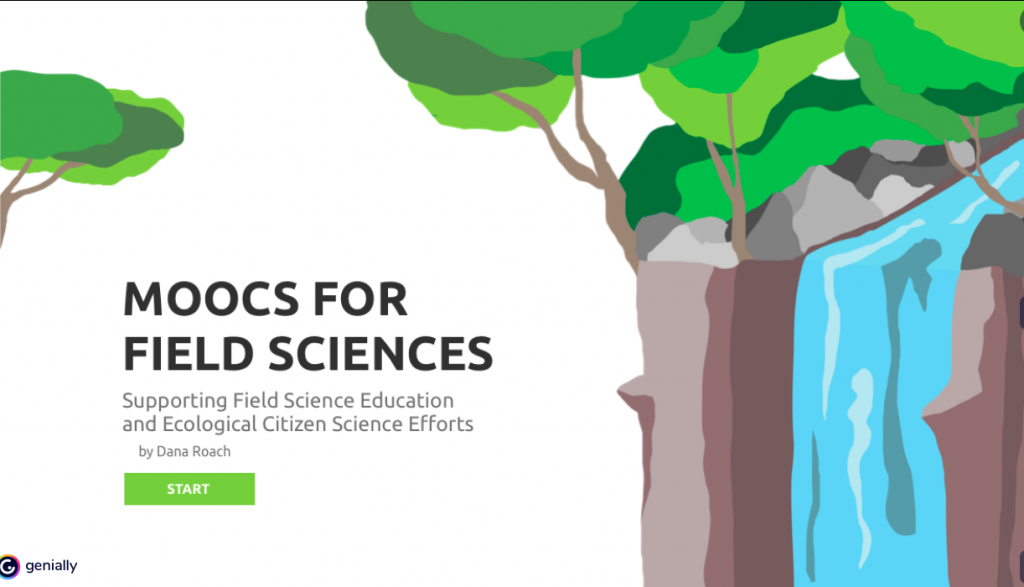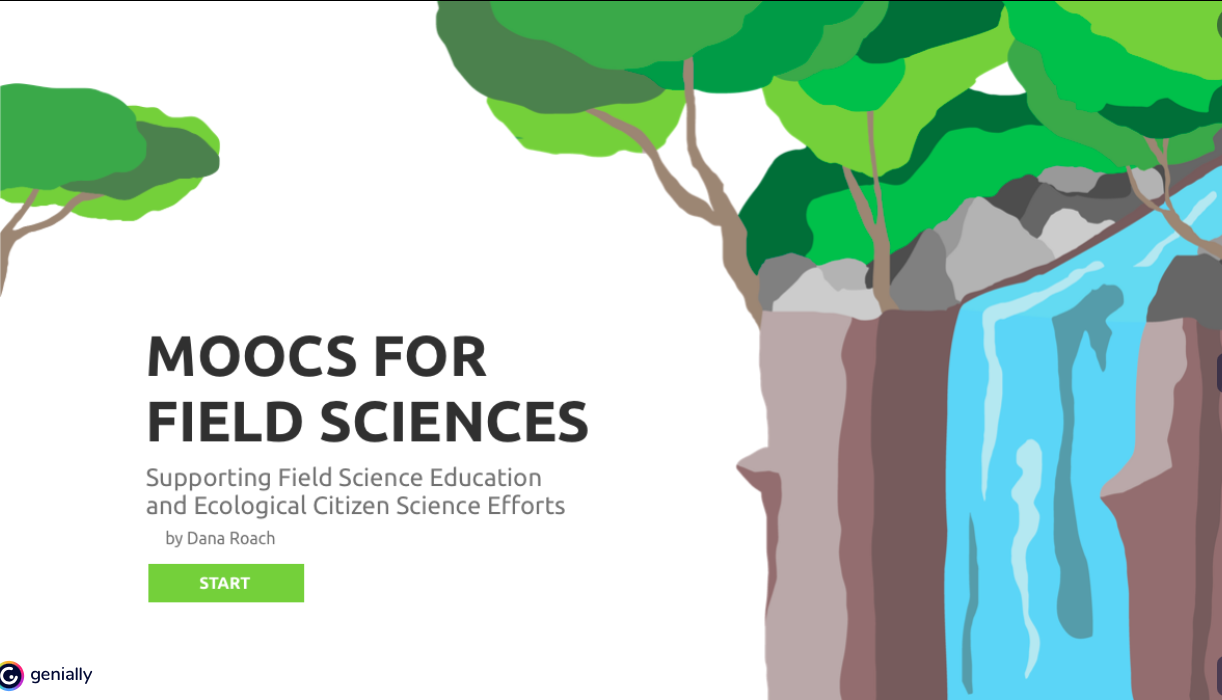
I have really enjoyed this semester learning about Mobile and Open Learning, and have especially enjoyed learning more about MOOCs, citizen science, augmented reality, and 5G capabilities and the affordances (and limitations) of each of those. For my A3 I wanted to build upon the work of my fellow ETEC 523 classmates and combine my interests from this course with my undergraduate and professional background in environmental sciences.
In my A3 I specify how MOOCs could be enhanced by augmented reality and 5G technologies to address a current gap in online educational opportunities–specifically in environmental science and related field sciences–and how these enhanced MOOCs could also address an existing problem within citizen science.
Click on the image or on this link to visit my A3 project. If, for whatever reason, the hyperlinks do not work here is the URL: https://view.genial.ly/605f98c64c2c980d6a9f2c06/presentation-moocs-for-field-sciences

Hi Dana
Thank you for such a cool idea in an Ecology based MOOC! Your passion and expertise really show from the way your A3 organized and the amount of current knowledge you have of the field. I do agree that AR technology could greatly benefit ecology especially with the mobility that could be more immersive educational experiences. I feel that our experiences with our A2 added an extra layer to the ability of adopting field sciences with mobile technologies. I think an AR version of geocaching with a focus on ecology as a MOOC that involved users being able to submit their own findings would make the idea come to life. I can think of so many different ways to use it to be present in our environment and to establish a connection with it. Great job!
Hi Dana,
As a Biology teacher I thoroughly enjoyed your presentation on the importance of field experience. Amid Covid this is even more challenging so I do appreciate the work you have done to provide this timely and relevant topic. I was intrigued by your use of the SWOT template for MOOCs. I had no idea what this was and saw with my research on it that it can be used to evaluate business ideas and also educational programs. I also learned that it is used to bring about change-thank you for teaching me about this template. I also enjoyed your treatment of citizen science. I believe our role as science teachers is about enabling our students to participate in real science. With mobile technologies, the potential for citizen science in real time is now possible . Using technology to facilitate field trips has been one of goals in the past year. Currently I am exploring using Arduino Science Journal, formerly Google Science Journal. I encourage you to try it out. Some of the most intriguing features include the sensors that are already built into the smartphone (iPhone 8 in my case). These measure important abiotic factors such as barometric pressure (hPA), brightness(EV-exposure value), accelerometer (XYZ), and so on. I downloaded it for iOS and have just been tinkering with it, but I plan to use it for a Biology Schoolyard trip this week. Most of our field trips are either virtual or in the schoolyard or at home because of Covid-19 restrictions. Finally, I like how you have referenced other ETEC 523 work completed those past semester, it demonstrates the regenerative nature of our course blog.
Hi Dana,
Wonderful A3!I agree with you that 5G and AR would have huge impact on field schools in Environmental Sciences. I made the same comment about Archaeology on team 5G’s A2 wall. I thought about this when I saw your cat skull example. Your technology could be used when finding new artifacts to view the whole piece that each new excavated object may belong to. I feel like your A3 is very well rounded, as it discusses how to compliment education gained through MOOGS, which are already accessible to the general public, but then you go even further and delve into citizen science. I think that this connection is invaluable because education goes beyond the walls of post secondary or even open education. When I was researching for possible ideas for our groups A2 in mobile collaboration, I came across a lot of research on video collaboration for environmental sciences. These included sharing platforms for videos of flood plains collected by citizens. Once again, great work!
Jennifer,
That is a great point! AR for archaeology would be an amazing way to teach the average person more about archaeology, but also an extremely useful tool for archaeologists!
I am glad that you liked my extension of my project into connecting MOOCs with citizen science. When I was reading other peoples’ (like Toby, Sarah, and Evelyn’s) A1s I was super interested in finding a way to make citizen science more approachable for people with no background in the topic and to also make the data gathered more reliable.
Thanks again for the feedback!
Hi Dana,
Your presentation on Genially is so well designed. It was great having the freedom to click into topics on the page that really interested me. The prospect of using AR in education is so exciting. With the new generation of digital natives, these students enjoy learning via using graphics more than text. I think using AR would really help in visually something that would otherwise be difficult to explain and imagine. Thanks for sharing!
Emily,
Thank you for the feedback! I am glad you enjoyed it! Especially after my A1 was so text heavy and people seemed overwhelmed by the wordiness I wanted to approach this project from a more visual approach while providing enough information. I agree that the newer generations are even more visually attuned than previous generations and I am glad that you can see the potential role of AR in the future of education!
Hi Dana,
I really enjoyed your Genially slideshow, it is such a versatile presentation tool! The SWOT analysis you completed was a new concept to me and it was a great way to further explore MOOC’s.
As a Biology teacher, I am excited with the potential that AR has for field studies as it can be used to explore ecosystems that may not be local or accessible for students. The technology provides life like experience and Bailensen (2015) in his research at Stanford, noted that the AR programs he created have affected real behavioral changes in its participants.
I have been exploring implementing citizen science projects in my classes using an Alberta app similar to iNaturalist, called Naturelynx. You can create missions that allow anyone in your area to participate in data collection for a goal that you determine, such as a species count. Do you have any experience implementing citizen science into your classes?
Stanford. [Jeremy Bailenson]. (2015, November 3). Immersive Science Learning in Virtual Reality. [Video]. Youtube. https://www.youtube.com/watch?v=GOYrC1hH6Ak
Deedee,
I am glad you enjoyed it! SWOT analyses were also a new concept to me until I saw Evelyn’s A1 on Citizen Science. It has been fun learning from one another in this course.
I am not actually a classroom teacher, so I have no experience with implementing citizen science into a classroom, but as an undergraduate student I participated in citizen science studies recording local pollinators found within our campus arboretum. I’d highly recommend integrating it in some way like that.
Though not a citizen science project, another fun project I did in school was partake in March Mammal Madness. We were assigned an animal and pitted against other animals in a bracket. We had to do the research to argue why our mammal was better or more likely to survive.
Check out this link for more information: https://libguides.asu.edu/MarchMammalMadness
Dana – this outstanding!! I really appreciate the level of detail you put in to this and love how you linked to A2 projects and other class posts. I am super interested in MOOCs and introducing them to my classes as a supplement or extension of their learning, so this project provides great insight. Thank you!
Meg,
I am so happy to hear that you enjoyed it and found it valuable! I was really excited by the prospect of being able to promote and build upon others’ work and apply my experience in environmental science to MOOCs. What topics of MOOCs are you hoping to introduce? I’d highly recommend you check Class Central for MOOCs in that topic and perhaps you can find one that is age appropriate for your students. I remember you mentioned that you are a food teacher- so if you were looking for food science or nutrition related courses here is what I found on Class Central just by searching “food”: https://www.classcentral.com/subject/food
I hope that helps!
Thanks Dana!
I have a few topics that I’d like to have my students look into a bit more: food security, food policy and foodborn illness (pathogens, food recalls, etc). I will definitely check out the link. As they are high school students, I’m looking for shorter courses as I hope that my students will use short lessons to determine what areas they may be interested in. I just don’t see them being engaged in a weeks long course!
I feel like I will need to introduce the concent of MOOCs to my students, so your presentation would be a great way to introduce it. Is there a recommended length for a MOOC for teens? I posted about MOOCs for teens a while ago, but not many people commented: https://blogs.ubc.ca/etec523/2021/02/28/moocs-for-teens/.
Meg,
Yes, I remember seeing your post! I didn’t come across any length recommendations in my research, nor any specifications for how to adapt MOOCs for teenagers. I would imagine though that within a larger MOOC if there are specific units that you want to teach your kids you could have them focus on just that unit. A lot of the MOOCs listed on Class Central include a syllabus so you can see how the class is broken down, and since it is a MOOC you can go at your own/your students pace and you don’t necessarily have to start at the beginning or go in sequential order. Feel free to pick and choose and hop around between the lessons as you see fit.
I’m sorry I couldn’t provide a more concrete answer, but I hope that helps at least a little bit!
Thanks so much Dana! It’s all good – I think we are all learning so much along the way, it’s just great to have so much great inspiration! I will definitely look at the syllabus and use that as a guide for my students.